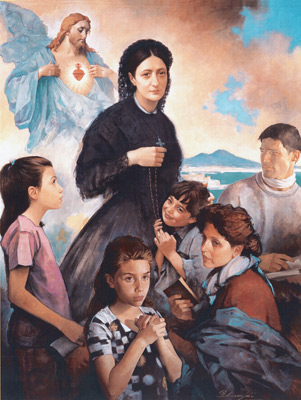 Caterina Volpicelli was born into an upper middle-class Neapolitan family on 21 January 1839 from which she received a sound human and religious formation. She was taught literature, languages and music at the Royal Educational Institute of St Marcellino by Margherita Salatino (the future foundress, with Bl. Ludovico da Casoria, of the Franciscan Grey Sisters of St Elizabeth). She belongs to that array of "apostles of the poor and marginalized" who in 19th-century Naples were a sign of the presence of Christ, the Good Samaritan, who comes close to all who are injured in body and spirit. Caterina had been trying to outshine her sister in society, frequently going to the theatre and the ballet, but prompted by the Lord's Spirit who revealed God's plan to her through the voice of wise and holy spiritual directors, she soon gave up the transient pleasures of an elegant and carefree life, to adhere with generous decision to a vocation of perfection and holiness.
Caterina Volpicelli was born into an upper middle-class Neapolitan family on 21 January 1839 from which she received a sound human and religious formation. She was taught literature, languages and music at the Royal Educational Institute of St Marcellino by Margherita Salatino (the future foundress, with Bl. Ludovico da Casoria, of the Franciscan Grey Sisters of St Elizabeth). She belongs to that array of "apostles of the poor and marginalized" who in 19th-century Naples were a sign of the presence of Christ, the Good Samaritan, who comes close to all who are injured in body and spirit. Caterina had been trying to outshine her sister in society, frequently going to the theatre and the ballet, but prompted by the Lord's Spirit who revealed God's plan to her through the voice of wise and holy spiritual directors, she soon gave up the transient pleasures of an elegant and carefree life, to adhere with generous decision to a vocation of perfection and holiness.Her chance meeting with Bl. Ludovico da Casoria on 19 September 1854 at La Palma, Naples, as she herself says, was "a rare stroke of prevenient grace, charity and favour from the Sacred Heart, delighted by the poverty of his servant". Bl. Ludovico led her to join the Third Order Franciscans and indicated to her the devotion to the Sacred Heart of Jesus as the one goal of her life, inviting her to remain in society to be a "fisher of souls". Guided by her confessor, the Barnabite Fr. Leonardo Matera, on 28 May 1859 Caterina entered the Perpetual Adorers of the Blessed Sacrament, but she soon left, for serious health reasons. Caterina's confessor showed her the monthly leaflet of the Apostleship of Prayer in France; from him she received detailed information about this new association with the diploma of Messenger, the first in Naples. In July 1867, Fr. Ramiere visited the palace of Largo Petrone in Naples, where Caterina was considering establishing her apostolic activities "to revive love for Jesus Christ in hearts, in families and in society". The Apostleship of Prayer would be the cornerstone of Caterina’s whole spiritual edifice and would permit her to cultivate her ardent love of the Eucharist and her outreach to others.
With the first messengers, on 1 July 1874, Caterina founded the new institute of "Servants of the Sacred Heart", at first approved by the Cardinal Archbishop of Naples, the Servant of God Sisto Riario Sforza, and later, on 13 June 1890, by Pope Leo XIII who granted the new religious family the "Decree of praise".
Concerned about the lot of the young, she then opened the orphanage of the Margherites, founded a lending library and set up the Association of the Daughters of Mary, with the wise guidance of Venerable Mother Rosa Carafa Traetto (d. 1890).
 She soon opened other houses: in Naples, in the Sansevero Palace and then at the La Sapienza Church in Ponticelli, where the Servants distinguished themselves in nursing cholera victims in 1884 and in Minturno, Meta di Sorrento and Rome. On 14 May 1884, the new Archbishop of Naples, Cardinal Guglielmo Sanfelice, osb, consecrated the Shrine dedicated to the Sacred Heart of Jesus which Caterina Volpicelli had had built next to the Mother House of her institutions. She built it specifically for adoration in reparation, as requested by the Pope, to support the Church in difficult times for religious freedom and Gospel proclamation. Caterina's participation in the first National Eucharistic Congress celebrated in Naples in 1891 (19-22 November), crowned the apostolate of the Foundress of the Servants of the Sacred Heart. Caterina Volpicelli died in Naples on 28 December 1894, offering her life for the Church and for the Holy Father. She was canonized April 25, 2009 at Saint Peter's Square.
She soon opened other houses: in Naples, in the Sansevero Palace and then at the La Sapienza Church in Ponticelli, where the Servants distinguished themselves in nursing cholera victims in 1884 and in Minturno, Meta di Sorrento and Rome. On 14 May 1884, the new Archbishop of Naples, Cardinal Guglielmo Sanfelice, osb, consecrated the Shrine dedicated to the Sacred Heart of Jesus which Caterina Volpicelli had had built next to the Mother House of her institutions. She built it specifically for adoration in reparation, as requested by the Pope, to support the Church in difficult times for religious freedom and Gospel proclamation. Caterina's participation in the first National Eucharistic Congress celebrated in Naples in 1891 (19-22 November), crowned the apostolate of the Foundress of the Servants of the Sacred Heart. Caterina Volpicelli died in Naples on 28 December 1894, offering her life for the Church and for the Holy Father. She was canonized April 25, 2009 at Saint Peter's Square.
No comments:
Post a Comment
Please be respectful in your comments. Anonymous comments are no longer taken.